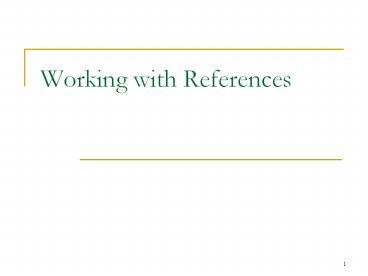Working with References - PowerPoint PPT Presentation
Title:
Working with References
Description:
e.g. String name; ... g. String objects. 10. Immutable Object Reference. For strings: String ... e.g. public Student clone() Student s = new Student ... – PowerPoint PPT presentation
Number of Views:56
Avg rating:3.0/5.0
Title: Working with References
1
Working with References
2
References
- Every object variable is a reference to an object
- Also true when an object is passed as an argument
- When the object is used, the reference is
followed to find the actual object
3
null References
- A variable that does not currently point to
anything is called a null reference - e.g. String name // name is null
- We can check if a variable contains a null
reference using the null identifier - e.g. if(name ! null)
- Java doesnt like null references
- but they can be hard to find for instance
variables
4
null References
- Look at StudentReferenceTest.java
- Note
- Compiler catches null reference in the local
variable - null references are never allowed in local
variables - but the compiler can not catch the null
reference in the instance variables - it doesnt know where the reference has been
5
null References
- Three situations can arise
- local variable null compile error
- null reference printed/passed this can be
missed initially - null reference used to call a method this gets
a null pointer exception - null objects dont have defined methods
6
The Picture
- Student s1 new Student(300012345, uid)
- s1.setFirstName(Sam)
Student ----------- studentNumber
300012345 firstName Sam lastName null ...
s1
7
Aliases
- Student s1 new Student(300012345, uid)
- s1.setFirstName(Sam)
- Student s2 s1
Student ----------- studentNumber
300012345 firstName Sam lastName null ...
s1
s2
8
Aliases
- s2.setFirstName(Pat)
- System.out.println(s1.getFirstName())
- \\prints Pat
Student ----------- studentNumber
300012345 firstName Pat lastName null ...
s1
s2
9
Copying
- If we really do want to copy an object, it has to
be done manually - Create a new instance, and copy the relevant data
over - Not an issue if there are no methods that change
the object i.e. for immutable objects - e.g. String objects
10
Immutable Object Reference
- For strings
- String s1 "Sam"
- String s2 s1
- s2 "Pat"
- System.out.println(s1)
- System.out.println(s2)
11
Changeable Object Reference
- For students
- Student s1 new Student(11111111,"u1")
- s1.setFirstName("Sam")
- Student s2 s1
- s2.setFirstName("Pat")
- System.out.println(s1.getFirstName())
- System.out.println(s2.getFirstName())
12
The clone Method
- Many classes contain a clone() method
- this returns a copy of the object
- i.e. a new object with the relevant info copied
- e.g.
- public Student clone()
- Student s new Student(studentNumber, userid)
- // copy the rest of the relevant data
- return s
13
Equality and References
- Compare references not objects
- Student s1 new Student(300012345,uid)
- Student s2 new Student(300012345,uid)
- Student s3 s1
- \\now s1s3 and s1!s2
Student ----------- 300012345 uid
Student ----------- 300012345 uid
s1
s2
s3
14
The equals Method
- Many classes define an equals method
- equal depends on the class
- For students
- public boolean equals(Student s)
- return studentNumber s.studentNumber
15
The compareTo Method
- Used for more general comparison
- a.compareTo(b) should return
- a negative int if a
- 0 if ab
- a positive int if ab
- Used by the built-in sorts
- one call to compareTo gives all the info needed
about the relative order - For students not 100 clear
- studentNumber?
- But not all objects are sortable
16
The this Reference
- It is often convenient/necessary to explicitly
refer to members of the current object - e.g. studentNumber s.studentNumber
- This can be confusing same variable name
- The special identifier this refers to the object
that the code is defining - e.g. this.studentNumber s.studentNumber
- This is more clear
17
Using this in Constructors
- In constructors, we need to pass a formal
parameter to fill a data member - public Student(long stunum, )
- studentNumber stunum
- Using this can clarify the situation
- public Student(long studentNumber, )
- this.studentNumber studentNumber































